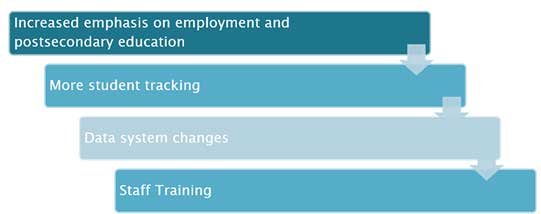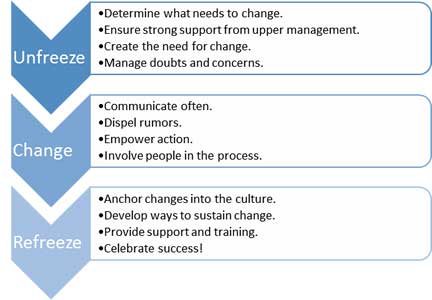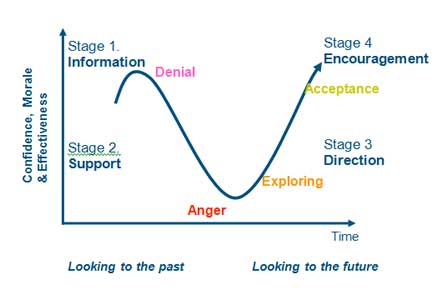Section Summary
Implementing a systemic change is a difficult task. In order to do it successfully, you need to understand the underlying reason for the change. In this section, you will review the basics of the WIOA and what it means for adult education, as well as the implications this law has for state reporting to the NRS. You will then learn about change management models that can provide a structure for dealing with the various aspects of implementing change.
By the end of this section you will
- understand the basic elements of WIOA,
- understand the impact of WIOA on NRS reporting, and
- understand the concept of change management and various models for addressing change process.
Overview of WIOA Changes
TIP: Copy and paste this section as a brief summary of WIOA to share with your local providers.
The WIOA became law in July 2014, amending the Workforce Investment Act of 1998. The performance accountability provisions of WIOA took effect on July 1, 2016. WIOA aimed to streamline the following core federal education and workforce training programs through a unified state plan of coordinated services:
- adult, youth, and dislocated worker employment training and Wagner-Peyser services;
- adult education and literacy programs; and
- vocational rehabilitation services.
It requires states to align their employment and training services in a way that better prepare a skilled workforce that meets employers’ needs, places an increased emphasis on accountability measures, among other reforms such as promoting work-based training, providing access to high quality training and improving services for individuals with disabilities.
Title II of WIOA addresses adult education and literacy and requires a joint state plan for coordination and service delivery. The adult education section of the plan covers the following areas:
- How the eligible agency will, if applicable, align content standards for adult education with state-adopted challenging academic content standards.
- How the state will fund local activities for:
- programs that provide adult education and literacy,
- programs for corrections education under Section 225,
- programs for integrated English literacy and civics education under Section 243, and
- integrated education and training.
- How the state will use funds to carry out state leadership activities under Section 223.
- How the state will use funds to carry out integrated English literacy and civics education activities under Section 243.
- How the eligible agency will assess the quality of providers.
It also strengthens the alignment of adult education with employers and postsecondary education and integrates English literacy and. Common performance measures were established for all core programs, affecting the NRS data collection and reporting. The new NRS measures as a result of WIOA are summarized in the handout in the appendix, New NRS Measures.
Implications for the National Reporting System
Figure 1. Implications of WIOA on the NRS

Employment and postsecondary education
WIOA places an increased emphasis on employment and postsecondary education. For example, under the new law, the credential performance measure includes a requirement of subsequent transition to postsecondary education or employment in order to count as an outcome. New performance measures also include median earnings and measurable skill gain. WIOA no longer requires collection of measures for entered employment or retained employment.
Student tracking
Reporting under WIOA requires more student tracking through interagency data sharing in order to measure success after enrollment. This may create an increased burden on states that will have to modify systems to be able to collect data and track, and follow up with students.
States now will have to track the following for students who enter the program:
- employment and wages,
- when the student received a secondary credential with employment or entry into postsecondary education, and
- attainment of postsecondary credential.
Changes to data systems
Because the law and data elements that states will be collecting are changing, the state data system also will need some modifications to collect the new information. Aside from changing accountability measures under WIOA, increased security and privacy issues and complex system architectures need to be addressed with the data system. WIOA’s requirement that the core federal programs coordinate and report on common performance indicators and increased student tracking requires increased diligence over data security and privacy. Planning for changes to the data system includes a process where state staff brainstorm their reporting requirements, inputs, and outputs. Then, with state adult education partner agencies, the agreements, constraints, and responsibilities each agency will take on must be determined. Finally, the new data system must be implemented. This entails testing the system, training staff in its use, then launching the system.
This toolkit will address approaches to data system changes in a later section.
Staff training
Staff training is one key to successful implementation of changes. State staff need to understand each aspect of the change as it relates to them and their work. It is important to ensure both state and local staff understand the changed requirements so they feel invested in the change, and also to ensure efficiency and fidelity to the changes. Since local program staff often are the people who collect and track the data, understanding what the new requirements are is critical for data quality. In addition, state staff must be able to provide ongoing training for data system challenges and for monitoring and evaluation purposes. In addition to providing staff training, it is crucial that state leadership engage in effective communication. See the Communicating Change section for more information.
Activities
Within the NRS regional training, topics were structured around each state’s joint state plans, submitted under WIOA. The intent was to have states focus on one or two areas of the adult education section of their plans and use the knowledge learned at the training to begin planning for implementation. The following activities were conducted in the training by state teams. These activities can be replicated with additional state staff who were not in attendance. In addition, we’ve provided suggested modifications to use the activities with local program staff.
Rate your state’s preparedness for each of the six state plan areas
States rated their preparedness to begin or continue to implement what is described in the joint state plan for each of the six state plan areas (Aligning of Content Standards, Local Activities, Corrections Education and other Education of Institutionalized Individuals, Integrated English Literacy and Civics Education Program, State Leadership, Assessing Quality). This rating will lead to the selection of priority areas that will be the focus of planning during the training. Usage of the template provided will enable teams to summarize key tasks required by their plan, describe what is already in place or has started, and assess their preparedness level (beginning, intermediate, or advanced). This activity can be revisited multiple times over a period of time to assess change in preparedness.
Adaptations
For use with local program staff: Understanding that local programs may not be involved in all six areas mentioned in the joint state plan, state staff can modify this activity for use with local programs by swapping out the six topics for activities they are responsible for, then rating how prepared they feel based on the state’s provided training and technical assistance. This may be a way to determine what areas of support need to be developed by the state for local staff.
Select a priority area
Recognizing that planning is a time-consuming but necessary part of implementing the state plan successfully, teams should narrow their focus area during this training. After determining preparedness level, teams discuss and decide which area they decide will be their priority. Teams are encouraged to select only one to two areas. Additional planners will be provided for each priority area. During this activity, teams will discuss which area to focus on, why, and how they came to that decision. Teams then will indicate on large chart paper their priorities. Teams will be encouraged during the session to collaborate with other teams who have the same priority area.
Adaptations
For use with local program staff: Building off the activity described and using the revised topics of relevance for local programs, staff will complete this activity for their own program and map out details of what and how they will work on implementing their priority area.
Change Management
What is change management?
Managing change is critical for effectively implementing change. Done correctly, it can help provide a comprehensive look at the effects of the issues at hand and enable leaders to address challenges by adjusting plans as needed. Change management can have several definitions, but at its core, it is a structured approach for ensuring that change is implemented successfully and in a way that the changes are long term. The underlying theory of change management is that change does not happen in isolation, but rather affects everything around it, including people, processes, behaviors, and systems. There are several different approaches and models of change management; however, all include the basic elements of (1) understanding change, (2) planning change, (3) implementing change, and 4) communicating change. Here, we describe a few of the most common change management models.
TIP:Time and communication are two keys to success. Transition from one stage to the next does not happen overnight so plan for plenty of time and a hands-on approach to dealing with challenges.
Lewin’s change model
Developed in the 1950s, Kurt Lewin’s change model uses the metaphor of the changing states of a block of ice to explain his process for change. This model is used in the training as a framework for planning change as a result of WIOA in the state. In this model, change follows the three-step process of (1) unfreeze, (2) change, and (3) refreeze. (See Figure 2.) Lewin’s approach begins the process by first examining why the change must occur. This is the unfreezing stage, where you break down the current way things are done; challenge current beliefs, behaviors, and values; and set the stage for introducing a new way of doing things in the next step. The unfreeze stage creates uncertainty. This is to be expected, and the uncertainty can come in all forms such as disagreement, fear, or excitement. In the change stage, as the group is looking for a new approach, it is important to remember to communicate effectively and explain how and why this change is beneficial to everyone, answer questions and deal with problems, and include staff in the efforts to find a solution. Once change begins to take shape and be accepted by staff, the group is transitioning into a more stable existence, or the refreeze stage. Things start to get back to normal in terms of day-to-day activities and routine. As part of this step, it is important to identify what supports the change and what barriers exist for sustaining the change. It takes people to ensure the change processes are kept up and continued. Finally as part of this step, it is important to celebrate the successes accomplished in order to thank and encourage the staff who embarked on the change process.
Figure 2. Lewin's Change Model

Activity
Change model reflection
This activity was used in the training to reflect on what is happening in states in terms of the six areas of adult education in their joint state plans.
Change is never easy. It can be uncomfortable and scary. The large scale change required under WIOA poses many opportunities for adult education, but it also requires new ways of functioning, communicating, and leading. Training participants are introduced to a well-known change model to help guide their thinking, planning, and communicating with their stakeholders as WIOA requirements and resulting changes are rolled out within their state. During this planning activity, training participants will think about and discuss the following questions: What stage of Lewin’s change model are you in? What pieces are you missing, according to the model on which you need to focus for your priority area? Then they will brainstorm some ideas to help address the change related to their selected priority area.
Adaptations
For use with local program staff: As with the previous activities, local program staff can focus on the elements of the state plan that affect them, then use this activity to determine how to move forward in implementing change in their local program tied to those made at the state level under WIOA.
For use with other partner agencies: This activity can be successfully used by other agencies such as the Department of Labor or Vocational Rehabilitation when addressing issues under their respective sections of the joint state plan. In addition, if a cross-agency meeting or summit is held to coordination each’s role in collaboration under WIOA, this activity can be used as a whole group exercise to find common ground as each agency is having to change some of their established processes in favor of joint plans.
Other Change Models
Lewin’s change model is just one example. The following are additional models for you to consider for use in your state. It’s not important which model is used; rather, it’s the intentional process of planning for and implementing change that is key.
Kotter’s eight-step change model
John Kotter introduced his eight-step process in 1995. This model is best used when you know change needs to happen, but you don’t know what to do or where to start. Kotter believed that for change to be successful, at least 75% of people need to be in favor of the change, so each step in this model is associated with people’s responses to the change. This model is easy to follow, but takes commitment to each step in order in order to create successful and sustained change.
- Create urgency: This step takes the most time and effort in order to build momentum for change among staff.
- Create a coalition: Identify leaders and key stakeholders who will commit to the change, and ensure a representative set of people is on board with the movement.
- Create the vision: Creating a clear vision or path forward is key to getting people to do what you are trying to achieve. If they can see where you are going, they will be more willing to execute the vision.
- Communicate: As with other change models, communication with people regarding change, the vision, and peoples’ questions and concerns also is an important part of the change management.
- Get things moving: Remove obstacles to change, deal with problems that may arise, reward those who are making things happen, and implement feedback in a constructive way.
- Focus on short-term goals: Focusing on attainable short-term goals can motivate and build morale as staff approach each element of the transition.
- Build on the change: Real change takes time, and quick wins are only the beginning of the process. Take each win in a smaller step, determine what went right and what needs improvement, and build on that momentum toward your goal.
- Anchor change in corporate culture: Incorporate change into everything you do. Create plans for continuing the transition through staff turnover, and reiterate progress made and new processes at every opportunity to reinforce the messaging.
The change curve
The change curve is a model used to understand personal transition and organizational change. (See Figure 3.) It is developed from Elisabeth Kubler-Ross’s grief model (1969), based on the five stages people experience when they realize they may be dying.
Figure 3. The Change Curve

- Stage 1: As change is first introduced, reactions to the challenge of the status quo may include shock or denial.
- Stage 2: As the status quo transitions to disruption of the environment, reactions move into a state of anger and fear about what is occurring. In this stage, it is key to have strong management, as this situation can turn into chaos quickly if not monitored.
- Stage 3: At this stage, people are starting to explore the new situation, let go of what they lost, and determine what the new changes mean.
- Stage 4: Finally, in the last stage, people begin to embrace the change and commit to rebuilding the organizational values and processes.
Additional models
Many other models exist for change management. You can find several of them in the resources here. As long as you select an approach that makes sense to you and your situation and follow it, the model does not matter.
- Major Approaches and Models of Change Management
- Change Management: Making Organization Change Happen Effectively
Ready for Change?
Now that you understand the background of WIOA and its implications for the NRS and have a framework for change management, how do you know you are ready for change? Several free tools exist online for assessing your readiness for undertaking a major organizational change. The following are some assessments you can use to determine this.
- Assessing Organizational Readiness for Change
- Checklist to Assess Client’s Readiness For Change
- Readiness Assessment and Developing Project Aims
- Who’s Ready for Whole System Change? Whole Field Assessment and the Change Readiness Checklist
Additional Resources
The following resources provide further reading about WIOA implementation, systemic change, change management, and change readiness.
- OCTAE: Workforce Innovation and Opportunity Act
- RSA: Workforce Innovation and Opportunity Act (resource no longer available)
- U.S. Department of Labor, The Workforce Innovation and Opportunity Act
- The Stages of Systemic Change
- The Systemic Change Process: A Conceptual Framework (resource no longer available)
- Change Readiness: Focusing Change Management Where It Counts
- Organizational Change Management: Readiness Guide
- Side-by-Side Comparison of Occupational Training and Adult Education & Family Literacy Provisions in the Workforce Investment Act (WIA) and the Workforce Innovation and Opportunity Act (WIOA) (resource no longer available)
- Unpacking WIOA Webinar (resource no longer available)

